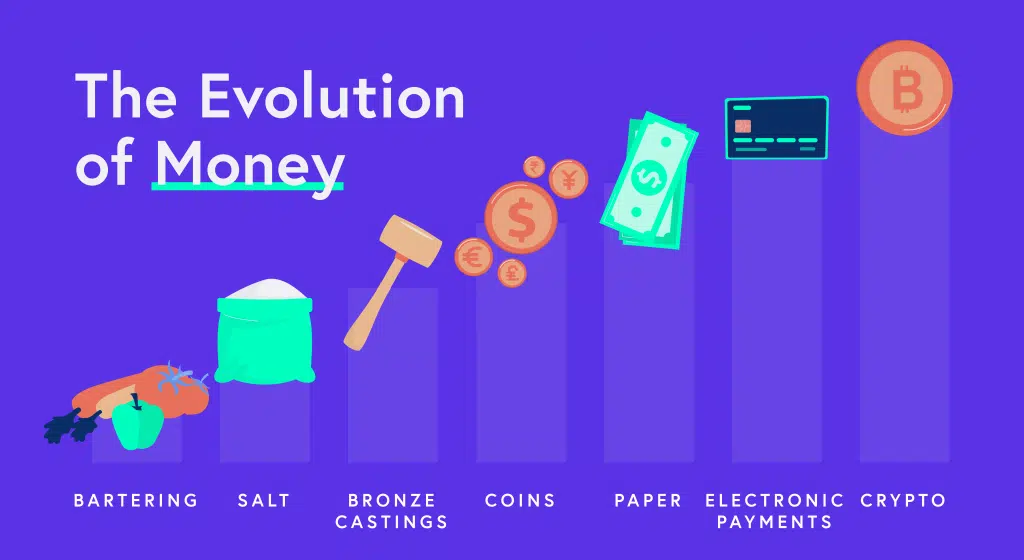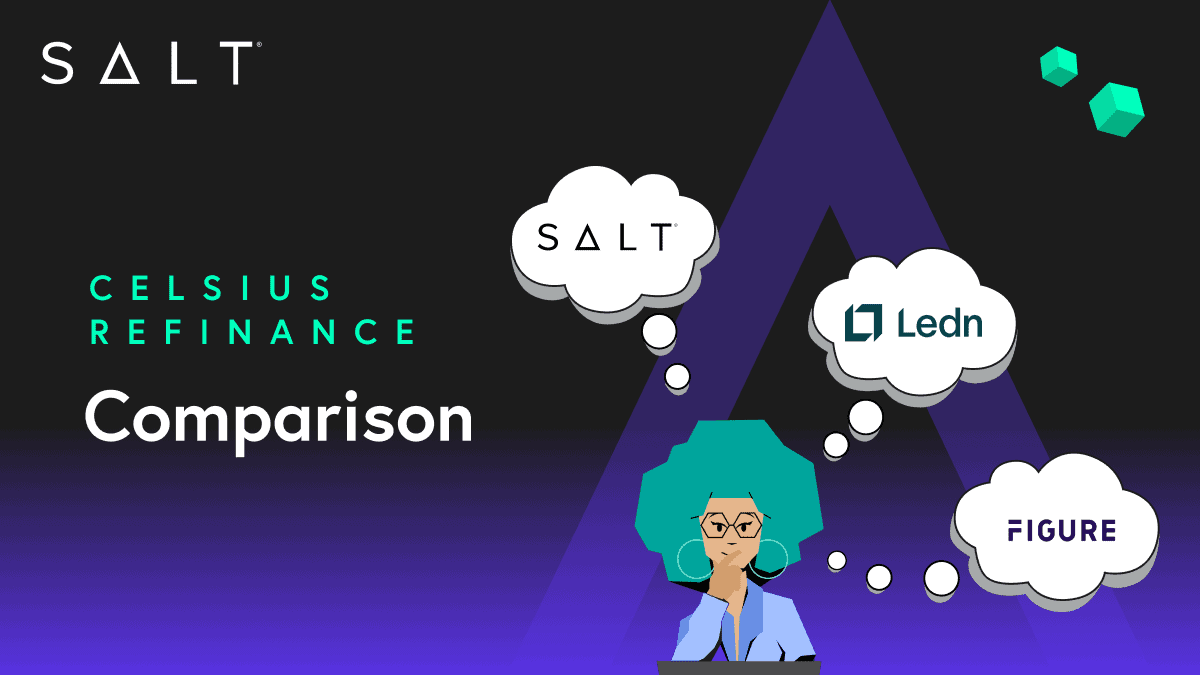Entrepreneur Jim Rohn famously mused, “Time is more valuable than money. You can get more money, but you cannot get more time.” Mr. Rohn may have been more right than he knew because while time has infinite value, money, by itself, has none. Whether you’re holding a dollar, a franc, some yen, a metal coin, or a seashell, it has no value—not until someone wants it. This goes for anything that can be traded, but the reality is far harsher when it comes to the paper people carry in their wallets in the hopes of exchanging it for goods and services. At the same time, money is, in some ways, an important block in the foundation of modern society. Why? Let’s take a closer look at the evolution of money to find the answers.
A brief history of money
Bartering
Before people carried around pieces of paper that symbolized value, they would trade goods and services with each other to make transactions. Each possession had a relative value. This means that what it meant to the holder was not necessarily equal to what it meant to the person to whom they wanted to give it in exchange for something else.
Take, for example, a farmer who grew potatoes but needed tomatoes. The farmer may approach his friend who grew tomatoes and offer him 10 potatoes for 10 tomatoes. The friend may say, “Well, to part with these 10 tomatoes, I’m going to need 15 potatoes.” If the potato farmer agreed and had that many potatoes to barter, he would present them, make the exchange, and both parties would leave the transaction satisfied.
On the other hand, if the potato farmer approached a different farmer with the same proposition, the transaction may not go as planned. If the second farmer already grew potatoes, he may ask for something else. It could be corn, beets, or another type of produce. But the other farmer may also prefer a tool or some form of service from the potato farmer. Each transaction was, therefore, relative. Currencies, although abstractions of value, brought concreteness to previously relative transactions. One of the progenitors of modern currency was salt.
Salt
Salt itself used to be a currency (fun fact: this is how we got our name). Far more than a common seasoning, salt has been at the center of trade and culture for multiple millennia—to the point where the word “salt” is at the root of the word “salary.” Salt, as a flavor additive, has long been a valued commodity. The word “salad” comes from when the early Romans used to add salt to vegetables and leafy greens.
Before the large mass-production of salt became commonplace, the production of salt was a time-consuming process. And as people figured out different ways of producing it, its production was limited to maintain its value. Therefore, people with a salt surplus had a coveted commodity.
The Egyptians used to use it as part of their religious offerings. This lead to salt becoming the currency of choice while trading with the Phoenicians. The practice continued for many centuries and spread across much of the developed world. Marco Polo, while traveling through China in the 11th century C.E., noted how the Chinese used to boil water to create a salt paste that, when formed into a cake, was worth two pence.
Bronze castings
As time progressed, around 770 B.C.E. the Chinese began developing bronze representations of the things they were trading. For example, if a farmer wanted to trade a hoe for a hammer, he would present a bronze casting of a hoe and give it to a carpenter—or someone else—in exchange for a small bronze hammer. The bronze statue could then be exchanged for the real thing. This solved the problem of having to physically transport large or cumbersome objects to places of trade.
Coins
Soon, it became more practical to use coins instead of little castings of valued objects. This approach maintained the convenience of being able to carry an item in your pocket and added an extra convenience: the ability to easily manufacture them.
The manufacturing of money was first performed in Lydia, which is now in the west of Turkey. This was the first mint. Inside, people manufactured coins that represented value. Around 600 B.C.E., Lydia’s ruler, King Alyattes, made the first official state currency. The coins were manufactured using electrum, which consists of a naturally-occurring combination of silver and gold. Each coin was stamped with a picture, and each picture represented a different value. Thus was born the concept of denominations. This system of minting denominated money helped facilitate a more efficient trading system, propelling Lydia to being a powerful, wealthy empire.
Paper
The Chinese made the switch to paper currency around 700 B.C.E. The distribution and use of the bills were carefully regulated by the emperor. In fact, on the bills, there was an inscription warning people that if they counterfeited the money, they would, literally, lose their heads.
After some time, banks began adopting the use of paper money. Inside the bank would be an amount of gold that corresponded to paper money the bank could issue to individuals with whom they did business. For example, if someone deposited half a pound, or eight ounces, of gold, at the bank today, according to the rates at the time of this writing, it would give them $15,197.60. The person would then be able to use that paper to purchase goods and services.
If the individual went and bought a new horse, perhaps spending $8,000 of his money, the person who sold the horse could take that paper money to the bank. The bank would then give the horse-seller $8,000 worth of gold. This gave birth to the modern concept of money, with gold as the underlying asset of value.
Currency-based conflicts
As more countries adopted the use of currency, some took advantage of the, admittedly arbitrary, value of money. They would do things that would cause the value of another country’s currency to rise. On the surface, this may sound like a good thing. However, when a currency is inflated, the cost of the goods within the country goes up. This inflation is due to the fact that more work has to be performed to produce the goods being traded. If someone were to do the same amount of work they did before the currency was inflated, they wouldn’t get paid enough to cover their bills. With goods that cost too much, a country wouldn’t be able to trade with others that could help them build the weapons and armies they needed to engage in war. Currency battles for the sake of weakening another nation continue to this day.
Credit cards
Similar to how going from bronze castings to coins made transactions easier, going from paper to credit cards made buying and selling more convenient for 20th-century consumers. With a credit card transaction, the money of the individual is still held within a bank, but the credit card is used to make the transfer. This is made possible due to two concepts: fungibility and transferability.
When a unit of value is fungible, it has the same value as another unit with the same denomination. For instance, a $10 bill in Boston has the same value as a $10 bill in Los Angeles. And the same goes for an electronic transaction that provides access to $10 stored in a bank. Thanks to fungibility, an individual can put $1,000 into a bank and get a credit card that has a $1,000 spending limit. The transferability of money refers to the fact that money can be moved from one party to another. In a credit card transaction, this happens electronically.
The bank that supports a credit card transaction can also allow the person to spend more than they actually have by lending the individual money. The conditions of the loan agreement are contained within the credit card contract. In many cases, the individual may not have enough money in the bank to cover the transaction. Therefore, they agree to put at least that much, and often a percentage more, into the bank in exchange for the right to spend the money the bank lent them. The use of debit and credit cards and the process behind credit card payments are pivotal factors in the evolution of money. They set the stage for a crucial monetary concept: electronic payments.
Electronic payments
Electronic payments are at the heart of the culmination of the evolution of money. In many ways, electronic payments solve the original problem money sought to tackle more efficiently. When money was first conceived, it’s creators were trying to create an abstraction of value that was fungible, transferable, and easy to spend and accept. With credit and debit card payments, electronic transactions become commonplace while providing a solution for everything money was meant to be.
However, one problem still remained: the middleman. If you have someone working as a go-between that generates wealth by charging you to spend money electronically, how can you guarantee a transparent, trust-worthy, error-free, corruption-free transaction?
Enter cryptocurrency. With the onset of bitcoin, cryptocurrency became an efficient way to both provide an electronic, tradable abstraction of value and, once again, provide the world with a one-to-one, two-person transaction, devoid of a middleman. But the crypto movement wasn’t arbitrary. The signs have been there for years.
The historical signposts that pointed to cryptocurrency
Because cryptocurrency is such an innovative idea, it’s easy to lose track of the fact that it was born, not so much out of innovation but out of necessity. The modern monetary system has, in many ways, been broken for quite some time. For many decades, there have been signs pointing to the need for a better solution.
Interest rate manipulation
Perhaps one of the most powerful historic indicators of the need for an alternative to typical fiat currency was revealed in the 1970s. The interest rates, designed to help stabilize the United States economy, ended up doing the exact opposite. When the government manipulated interest rates to help slow the inflation of common goods, it ended up having the opposite effect. Inflation skyrocketed as certain goods saw huge leaps in their prices. While some people could afford to pay the higher costs, others couldn’t and had to go without essential items.
Even though companies selling their goods to other Americans during a period of inflation may benefit, those exporting American-made goods suffer. Because it costs more to produce goods in the United States, companies have to charge buyers from other countries more. Consequently, some goods become unaffordable for international buyers and they look to other countries to get what they need. This impacts the gross domestic product (GDP) of the country suffering from inflation, hurting their overall standard of living. Because the government can choose to print money anytime it wants, regardless of whether or not there’s enough gold to support the printed currency, inflation in the modern system can easily spin out of control. As in the 1970s, it can start with a poorly adjusted interest rate and have global implications.
With cryptocurrency, the supply of each token is either limited or controlled by the currency’s governance team—a group of individuals and token-holders who make decisions using a voting system. This helps control the inflation of each cryptocurrency. Also, because the currency isn’t hindered by national borders, you have one common means of purchasing goods and services, and its value is the same regardless of where you are.
The housing crisis
The financial crisis of 2007 was another bellwether for the global economy because it highlighted the corruption that can occur when you have profit-hungry “middlemen” involved in transactions. When someone wants to buy a home, they often have to get a loan from a bank. The bank decides who they will lend the money to, as well as how much they will make that person pay, in interest, for the right to use that money. In theory, the system makes sense. However, as the world saw in 2007, when the banks, hungry for profits, abuse the system and those involved, it can have far-reaching implications.
If the interest rate at which money is lent isn’t decided by a bank but by mathematical equations that take into account real supply and demand factors, the lenders can only earn more by lending more. Manipulating interest rates for the bank’s bottom line would be a thing of the past. Cryptocurrency also addresses the problem of predatory lending. The economic crash was partially a result of banks lending money they knew couldn’t be repaid—and then selling the problematic loan to another, unsuspecting, bank. When transactions happen between two people instead of three, the middleman, and his potentially greedy ambitions, are removed. Cryptocurrency, therefore, eliminates some of the major causes of the financial crisis of 2007.
SALT Lending: A historical turning point in the evolution of money
Throughout history, the utility, divisibility, verifiability, and fungibility of salt made it a perfect asset to be used as a method of trade and currency around the world. Through the products and services at SALT, the legacy continues. SALT is now bridging the gap between cryptocurrencies and traditional lending.
Even though cryptocurrencies are, in many ways, a superior monetary solution, they are still not yet widely accepted. With SALT, holders of crypto can get loans using their digital assets as collateral. You can then spend the USD or stablecoin you get any way you’d like. SALT empowers those in the cryptoverse, allowing them to turn the most innovative monetary solution since, well, salt, into liquid assets.








